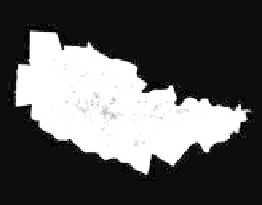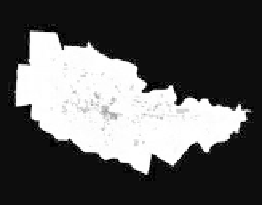Information Technology Reference
In-Depth Information
Figure 16.3.
Results from UrbanSim for Eugene/Springfield, Oregon, forecasting land use
patterns over a fourteen-year period. These results arise from the simulated
interactions among demographic change, economic change, real estate devel-
opment, transportation, and other actors and processes in the urban environ-
ment. Map (a) shows the employment density in 1980 (number of jobs located in
each 150 150 meter grid cell). Darker area indicates higher density. Map (b)
shows the predicted change from 1980 to 1994 (where darker area indicates a
greater change), and map (c) the predicted employment density in 1994. In a his-
torical validation of the model, this result was then compared with the actual
1994 employment, with a 0.917 correlation over a 1-cell radius.
(a) 1980 Employment
(b) Change 1980-1994
(c) Resulting 1994 Employment
and more specifically freedom from bias. The simulation should not discriminate unfairly against
any group of stakeholders, or privilege one mode of transportation or policy over another. A second
is accountability. Insofar as possible, stakeholders should be able to confirm that their values are
reflected in the simulation, evaluate and judge its validity, and develop an appropriate level of con-
fidence in its output. The third is democracy. The simulation should support the democratic process
in the context of land use, transportation, and environmental planning. In turn, as part of supporting
the democratic process, Borning et al. decided that the model should not a priori favor or rule out
any given set of stakeholder values, but, instead, should allow different stakeholders to articulate the
values that are most important to them, and evaluate the alternatives in light of these values.
Handling Widely Divergent and Potentially Conflicting Stakeholder Values
From the standpoint of conceptual investigations, UrbanSim as a design space poses tremendous
challenges. The research team cannot focus on a few key values, as occurred in the Web Browser
project (e.g., the value of informed consent), or the Room with a View project (e.g., the values of
privacy in public spaces, and physical and psychological well-being). Rather, disputing stakehold-
ers bring to the table widely divergent values about environmental, political, moral, and personal
issues. Examples of stakeholder values are environmental sustainability, walkable neighborhoods,
space for business expansion, affordable housing, freight mobility, minimal government interven-
tion, minimal commute time, open space preservation, property rights, and environmental justice.
How does one characterize the wide-ranging and deeply held values of diverse stakeholders, both
present and future? Moreover, how does one prioritize the values implicated in the decisions? And
how can one move from values to measurable outputs from the simulation to allow stakeholders
to compare alternative scenarios?
As part of addressing these questions, the research group implemented a Web-based interface
that groups indicators into three broad value categories pertaining to the domain of urban devel-
opment (economic, environmental, and social), and more specific value categories under that. To




Search WWH ::

Custom Search